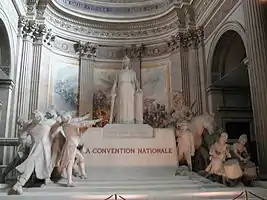François-Léon Sicard
François-Léon Sicard (April 21, 1862 – July 8, 1934)[1] was a French sculptor in the late 19th and early 20th century. His credits include work on the adornments of the Louvre, and numerous sculptures around the world.
François-Léon Sicard | |
|---|---|
 | |
| Born | April 21, 1862 Tours, France |
| Died | July 8, 1934 (aged 72) Paris |
| Nationality | French |
| Occupation | Sculptor lithography |
| Awards | Prix de Rome 1891 |
Sicard was born in Tours, studied with Louis-Ernest Barrias, and is known for his lithography and his fiercely patriotic original works of art. Despite the prolific populace of noted works throughout Europe, surprisingly little is known about Sicard himself. His work is very similar to that of Gustave Crauk (1827–1920) and Antoine-Augustin Préault (1809–1879), and he may have worked in collaboration with Crauk on some of his sculptures during the early 20th century.
Notable works
Some of his noted sculptures include:
- Le Bon Samaritain (The Good Samaritan)
- Oedipe et le Sphinx (Oedipus and the Sphinx)
- the Archibald Fountain in Hyde Park, Sydney, Australia
- four atlantes for the Hôtel de ville in Tours, circa 1900, for architect Victor Laloux
- Autel de la Convention nationale or Autel républicain (Panthéon de Paris, France, 1913)
Gallery
 Le Bon Samaritain (1896), jardin des Tuileries, Paris.
Le Bon Samaritain (1896), jardin des Tuileries, Paris. Monument à la Convention nationale (1913), Panthéon de Paris.
Monument à la Convention nationale (1913), Panthéon de Paris. Monument to Georges Clemenceau
Monument to Georges Clemenceau
References
- "François Léon SICARD". Genea Net. Retrieved 21 December 2012.
- Daniel Cady Eaton, A Handbook of Modern French Sculpture, Dodd, Mead and Company, 1913, pages 273-274.
External links
| Wikimedia Commons has media related to François-Léon Sicard. |
- François-Léon Sicard in American public collections, on the French Sculpture Census website

This article is issued from Wikipedia. The text is licensed under Creative Commons - Attribution - Sharealike. Additional terms may apply for the media files.